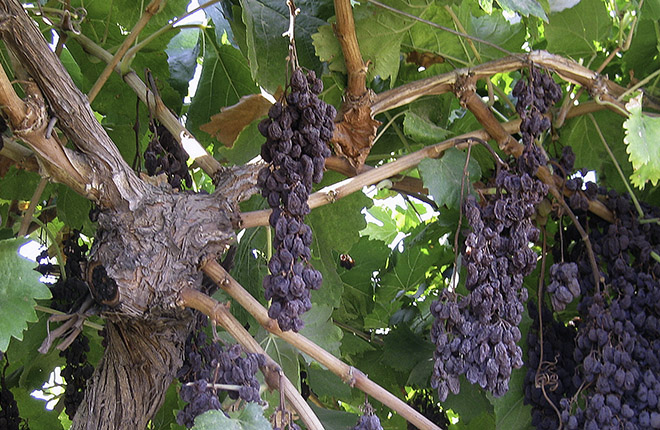Labor-Saving Raisin Grape
Harvesting raisin grapes can be a labor-intensive process. With many grape varieties, about 2 weeks before the harvest, crews must cut the canes, which are the long branches that actually produce the grapes. Once the canes are cut, the grapes begin to wilt on the vines so that they can later be shaken onto trays.
That may change soon. A new raisin grape developed by Agricultural Research Service (ARS) scientists in California dries naturally on the vine, eliminating the costly step of cane cutting.
|
|
"Sunpreme" is a green raisin grape similar in size and quality to the Thomson Seedless, an industry standard. It was bred and patented by retired ARS horticulturalist David Ramming, and its release is being directed by ARS plant geneticist Craig Ledbetter and his colleagues at the San Joaquin Valley Agricultural Sciences Center. So far, five nurseries have a license for Sunpreme, and some are already taking orders from grape producers. "We expect these grapes to become extremely popular," Ledbetter says.
His optimism is based on economics. Cane cutting costs about $130 per acre, which is roughly 36 percent of total harvest costs, Ledbetter explains. Sunpreme was bred for raisin production in the San Joaquin Valley, where almost all of the nation's raisins are produced. There are roughly 200,000 acres of vineyards producing raisin grapes in the San Joaquin Valley, so Sunpreme could annually save millions of dollars in production costs.
To give growers added guidance, Ledbetter and his colleagues compared the overall quality of Sunpreme grapes grown under three irrigation levels and two pruning techniques. The three irrigation levels were: replacing 100 percent of the water used by the vines and soil; reducing to 50 percent water at berry softening; and a "shock treatment," where the vine was initially irrigated, then denied water for 2 weeks, and finally given a 50-percent water treatment.
Results from 6 years of irrigation showed that the "shock treatment" saved the most water, but it could be tricky for growers to implement. A better alternative is to irrigate at a 50-percent replacement level, Ledbetter says.
After 2 years of study, Ledbetter confirmed that Sunpreme vines only need to be "spur pruned," which generally requires less skill than "cane pruning." (In spur pruning, thick, permanent branches known as "cordons" run along a support trellis. Canes growing off the cordons are pruned back to short "spurs," which produce the fruit. In cane pruning, the canes run directly along the trellis, and some are pruned back so that others can produce more robust fruit. Knowing which canes to prune back can take training.) Grapes from spur-pruned vines were comparable in size, quality, and number to grapes from cane-pruned vines, Ledbetter says.
Results of the study were published in January 2016 in the Journal of the American Pomological Society. — Dennis O'Brien, ARS Office of Communications.
Key Facts
- Raisin grapes are normally cut off the vine to dry out.
- A new ARS-bred raisin grape dries on the vine, saving labor costs.
- Study provides irrigation and pruning techniques for the new grape.
Full Story








